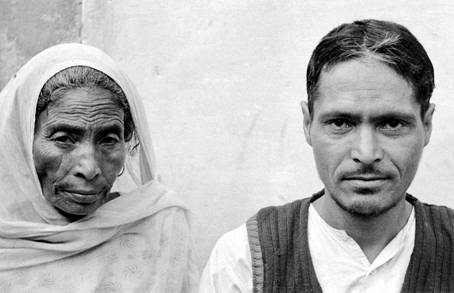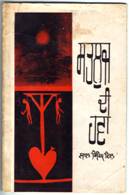Life and poetry of a Wandering Heart
Poet of the Revolution: The Memoirs and Poems of Lal Singh Dil, Translated from Punjabi by Nirupama Dutt. Pages 167, Price Indian Rs 399. Penguin Viking, 2012. isbn 9780670086559.
One must congratulate Nirupama Dutt for two things. First, for presenting, through this English translation, the life story (Dastãn, Chetna, 1998) and some poems of Lal Singh Dil (1943-2007), a Punjabi ‘Naxalite’ poet, to non-Punjabi readers, certainly in the Indian subcontinent but also across the seven seas. Second, for having succeeded in seducing a mainstream Indian publisher to do a ‘lowbrow’, ‘provincial’ and an ‘unsalable’ regional language author. This is a great achievement, and admirers of Lal Singh Dil and readers of Punjabi poetry and literature must thank her profusely. For her own self it seems to have been a labour of love for a friend who unfortunately is no more alive to show his gratitude.
Dil’s autobiography, Dastãn, presents many roadblocks even for the most determined translator. Dil’s narration looks an incoherent, at places a disorganised, mass of often disconnected and incomplete anecdotes that follow one another pell-mell. Quite often he leaves his incidents hanging and incomplete. He does not give us any dates, so we are forced to guess what happened and when. There are many gaps in the narrative. We don’t know when and how exactly he turned a Naxalite. Dutt has tried to remove many of these flaws through her copy-editing. She has given shape to Dil’s text by providing chapter headings, though characterised by journalistic flourishes, and made it look thematically coherent. This would certainly facilitate a reader new to Lal Singh Dil.
Another interesting thing about the book is that Dutt provides, in her Introduction, a kind of postscript to the poet’s own account. She in a way completes the story that was left midway by the poet, by providing some glimpses of Dil’s life after his return from Uttar Pradesh in early1980s till his death in 2007. In many ways her account is very moving as well as revealing, though somewhat romanticised. Prem Prakash’s Foreword (1998) also adds to and provides many insights into the poet’s life and character.
However, I have a few issues with the book. The title itself, Poet of the Revolution, sounds abstract. It does not by itself convey the concreteness of the revolutionary aspect of Dil’s life and poetry. And in Dutt’s Introduction no real attempt is discernible to clarify what she means by the expression ‘the Revolution’. To say that he was a Naxalite revolutionary is to say the obvious.

Lal Singh Dil with his mother Chint Kaur. Samrala. 1978
photo by Amarjit Chandan.
There are one or two issues with her copy-editing. Dutt has cut nearly forty pages from the Punjabi version of Dil’s memoirs, Dastãn, consisting of 169 pages. Pages 46-65 dealing with Dil’s childhood and the milieu in Samrala in which he grew up, do not form a part of Dutt’s text. The part dealing with Dil’s life in Uttar Pradesh has been heavily edited and reduced nearly by half. And she has altogether omitted the last few pages (p.157-169) containing Dil’s account of his life after his return from Uttar Pradesh to Samrala. She may have had good reasons for doing all this, but she should have spelled them out clearly. One may feel that the editing has been over-done. The English reader might miss some features of the world in which Dil lived, and many warts and all in Dil’s life and character.
A few other alterations are more questionable. For example, the pock-marked face (p.19, Dastãn) of a girl towards whom the boy Lal was attracted becomes one ‘with dimpled cheeks’ in her Memoirs, as does the face of the police havaldar whose pock-marked face (p.110) reminds Dil of this girl! The ‘six month rigorous imprisonment’ (p.115) becomes ‘a few years of rigorous imprisonment’. The village Kudeli in the Punjabi text (p.126), after which Lal Singh named one of his most beautiful poems, ‘The Women of Kudeli Village’, becomes Kuraili in Dutt’s text. I am afraid she has made the first two changes to romanticise Dil’s life story. The last one might be a misprint.
Finally, what makes Dil’s story so memorable and readable? As I see it, one can detect at least four powerful currents flowing through the narrative. First, the sheer and abject ordinariness of the lives of the people that constitute Dil’s world. Second, a nagging sense of the discrimination he faced in the village, at school and college, at the police station and even after his conversion to Islam, and in the Movement from his fellow revolutionaries. Third, his strong yet unfulfilled longing for the love and company of a girl, and later a woman. And fourth, his passion to write poetry under circumstances that strain the imagination. At the background, of course, is the awareness that the revolution on which he had, in his naivety, pinned so much hope never came about.

Cover of Dil’s first collection Satluj di hawa, 1st edition 1971
Lal Singh’s Dastãn is a flawed document, but flaws do not diminish the value of the book, for it still shines like an uncut diamond, and is a reflection of the poet’s edgy and maverick existence. This is obvious from at least one part of the narrative, certainly the most well written part of it (and almost untouched by Dutt’s scissors), in which Dil narrates his participation in the farcical attack on the Chamkaur police station, his arrest and all that happens to him during his police custody until he is sentenced to six months rigorous imprisonment. This part is a superb piece of narrative - lucid, coherent and complete. Dil seems to remember each minute detail of the physical and mental torture inflicted upon him, including the names and faces of his tormentors. The description is straightforward, graphic, matter of fact; and completely unsentimental, devoid of rancor, as if he were talking not about himself but an unknown person. He is deserted by his friends and family who are certainly incapable, and unwilling, to provide any succor to this naïve and credulous man who remains steadfast in the face of all that he suffers.
His life after release from jail is another bizarre tale of wanderings, almost like that of a foraging animal, in search of a measly means of livelihood, solace, a resting place and freedom from his greatest foe, the ever-chasing monster of social exclusion; a life which finally folds up near his home town, Samrala, as a vendor of tea where he dies a sick man, perhaps mentally unstable, and an edict, supported by few friends.
Dil’s life and poetry are a devastating critique of the Indian state and society as well as the democratic and egalitarian presumptions of our dominant classes and castes. We must thank Nirupama Dutt for showcasing this man’s life and poetry to the English readership.
─ Trilok Ghai E: tcghai@rediffmail.com
about the reviewer
Trilok Ghai retired as Associate Professor in English literature from a college under Delhi University in 2002. He has published two short novels The Stricken Moth (1984) and Alone in the Wilderness (2000), both from Writers Workshop, Kolkata. He has also published poems in the Journal of the Poetry Society (India) and did poetry reviews (1991-94) for the same journal. His translations of Pash have been published as: Pash: A Poet of Impossible Dreams (Shilalekh Delhi, 2010) and more recently his translations of Lal Singh Dil‘s five poems have been published in the latest issue of Modern Poetry in Translation (Series 3 Number 18, Oxford).
[December 2012]
